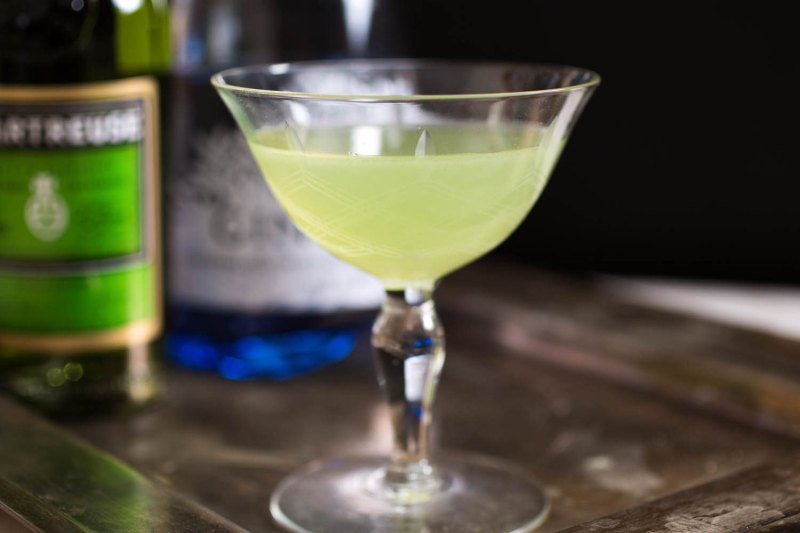Gin often plays a prominent role within classic cocktail culture. Such is the case with The Last Word cocktail, a delightful green concoction enlivened by the aromatic clear spirit. It’s a cocktail that has practically lived two lives: one as it was born during the heyday of early 20th-century American bar life and another that started about two decades ago.
How did it come about? Drinks folklore says The Last Word was devised by Frank Fogarty at the Detroit Athletic Club circa 1916. Oddly enough, Fogarty was not a bartender but an award-winning vaudeville comedian. Regardless of his progression, he came up with a darn good cocktail that uses some rather obscure ingredients.
Early on, the cocktail was a hit. The Gatsby era was drawn to both its faded green hue and interesting flavor profile. Then, the war came, and The Last Word was practically brushed under the bar rug until the speakeasy craze of the early aughts brought it back to life. Gin-adoring bars like Zig Zag Cafe in Seattle and the late Pegu Club in NYC reminded us of just how great the drink is. In fact, beloved cocktail artist Murray Stenson of the former establishment is credited with resuscitating the cocktail and giving The Last Word, well, the last word.
The Last Word drink recipe

Ingredients
- 3/4 ounce London dry gin
- 3/4 ounce green Chartreuse
- 3/4 ounce Luxardo maraschino liqueur
- 3/4 ounce fresh lime juice
Method
- Shake all ingredients with ice.
- Strain into a chilled coupe.
- No garnish.
Why The Last Word is such a good cocktail
One of the many pros The Last Word offers is its memorable makeup. The recipe is easy to memorize, as it’s equal parts of the four main ingredients: gin, Green Chartreuse, Luxardo, and lime. And it stays simple even after being mixed up, the classic recipe requiring no added frills in the form of garnishes. At its core, it’s simply a wonderfully biting drink born of the blissful pre-Prohibition era. Many call it pungent in the best of ways.
When preparing one, it seems like the drink could use more gin until you realize that the two other liqueurs pack some booziness as well. Given that three of the four ingredients are alcoholic, start on the lighter side. You can always dial it up if you want a higher-octane cocktail. Either way, the end result is truly unique, a little funky, and a little herbal, with subtle hints of mint, gentian, and orchard fruit.
Which gin to select? Something bone dry is preferred as that particular style will offset the liqueurs at play here. We suggest something like No. 3 or Fords. If you’re lacking selection, a big brand like Tanqueray does the job. Some bartenders opt for an overproof gin to take on the big notes offered by both liqueurs. That’s entirely up to your taste and whether you’re up for a hangover the next day.
Per usual, squeeze your own citrus. This is particularly important as The Last Word cocktail should finish dry and sour. You’ll need quality lime to achieve that finale. It’s not uncommon to see the drink served with a cherry garnish, but we believe that only distracts from this cult classic (not to mention it can tamper with the flavors if you eat the cherry mid-drink). Just mix up the four ingredients in equal parts and take a trip back in time to the golden era of gin cocktails. And, if you like, repeat.
Why no garnish with The Last Word?
There are actually two schools of thought on the garnish (or lack thereof) for The Last Word cocktail. One is that no garnish is classic. Many believe The Last Word drink is best served without a garnish. The idea is that the drink’s flavor profile is complex and balanced enough on its own, and a garnish might muddle the taste. The pale green hue of the drink can also be quite attractive with no additional elements.
For others, they may add a garnish as a subtle complement to the drink. A lime twist or a brandied cherry are popular choices. The lime adds a citrusy aroma and a touch of acidity, while the cherry brings a hint of sweetness and complements the botanical notes in the gin.
What does The Last Word taste like?
The Last Word is memorable for many reasons, but primarily because of its unusual flavor profile. With the gin and lemon juice, you might expect something like a gin gimlet, and those flavors of juicy citrus and sharp gin botanicals are certainly present. But there’s also the strong herbal flavors that come from the Chartreuse, which is a complex spirit even just on its own. Adding green Chartreuse to gin and lime brings out the herbal botanicals in the gin and the fruity notes from the lime, but it also ups the alcohol level, meaning that there’s a boozy punch that’s almost like a martini.
And then, on top of all of this, you add the Luxardo. This adds an almondy, almost nutty note to the drink, as even though it’s technically a cherry-based spirit it has more of a flavor profile of almonds than on cherries. There is a kind of sweetness to the Luxardo, though, too, which helps balance the boozy heft of the gin and Chartreuse.
It’s a challenging drink to describe, which is why it’s so worth trying for yourself — and why it’s popular among cocktail fans. It’s certainly not a mindless easy sipper, but it’s not harsh like some very spirit-forward cocktails can be either. It’s intriguing, with many layers of flavors, bringing together a bit of everything from the realms of bitter, herbal, fruity, and just a tiny bit of sweet. There’s really no other cocktail like it.



